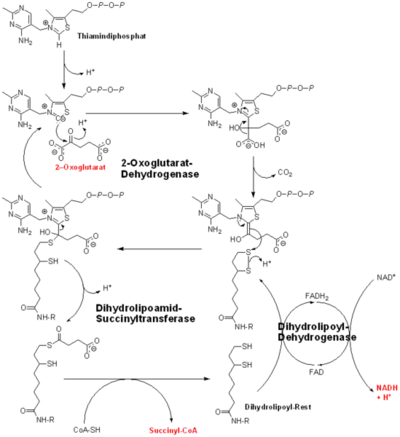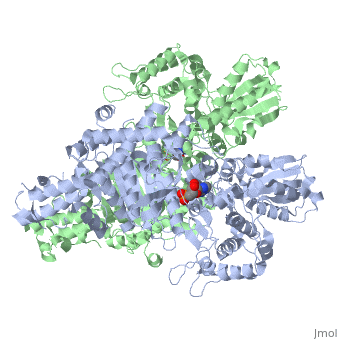Introduction
2-Oxoglutarate dehydrogenase (OGDH) is an enzyme that plays a crucial role in cellular metabolism. It is part of the tricarboxylic acid (TCA) cycle, also known as the citric acid cycle or Krebs cycle, which is a central metabolic pathway in most organisms.
The OGDH enzyme catalyzes the conversion of 2-oxoglutarate (also known as alpha-ketoglutarate) to succinyl-CoA. This reaction is an important step in the TCA cycle, where 2-oxoglutarate is oxidized, and its energy is harvested in the form of reduced coenzymes, such as NADH and FADH2.
The reaction catalyzed by OGDH involves the decarboxylation of 2-oxoglutarate, resulting in the release of carbon dioxide and the formation of a thioester bond with coenzyme A (CoA). The enzyme complex responsible for this reaction is called the 2-oxoglutarate dehydrogenase complex (OGDHC). OGDHC is similar in structure and function to other multienzyme complexes, such as pyruvate dehydrogenase and alpha-ketoglutarate dehydrogenase.
The OGDHC consists of three main components: E1 (2-oxoglutarate dehydrogenase), E2 (dihydrolipoyl succinyltransferase), and E3 (dihydrolipoamide dehydrogenase). Each component plays a specific role in the overall reaction, with E1 catalyzing the decarboxylation of 2-oxoglutarate, E2 transferring the succinyl group to CoA, and E3 regenerating the oxidized form of lipoamide.
The activity of OGDH is regulated through several mechanisms, including allosteric regulation and reversible phosphorylation. Various metabolites, such as NADH, ATP, and succinyl-CoA, can modulate the enzyme's activity, allowing for fine-tuning of the TCA cycle in response to the cell's metabolic needs.
The OGDH enzyme and the TCA cycle are essential for cellular energy production and the generation of metabolic intermediates for biosynthesis. Dysregulation or dysfunction of OGDH can contribute to metabolic disorders and diseases, highlighting the importance of this enzyme in maintaining cellular homeostasis.
Key Features
2-oxoglutarate dehydrogenase is a complex of three components: E1, E2 and E3. The enzyme 2-Oxoglutarate Dehydrogenase E1o (OGDH) is a subunit the 2-Oxoglutarate Dehydrogenase (EC Number 1.2.4.2) multi enzyme complex. This subunit is a homo-dimer and one of three enzymes that make up the multi-enzyme complex of 2-Oxoglutarate Dehydrogenase. Each of the that make up the homo-dimer have an cofactor that facilitates the catalysis. E1o is not categorized in the Structural Classification of Proteins (SCOP); however, the of one of the dimers shows that this enzyme has large sections of alpha-helices followed by a large sections of parallel beta-pleated sheets these alpha and beta subunits are fused as a single polypeptide [1]. E2 component is dihydrolipoyl succinyltransferase or dihydrolipoamide succinyltransferase (DLST) with lipoic acid as coenzyme and E3 is Dihydrolipoamide dehydrogenase (DLD) with FAD as coenzyme. The 2-oxoglutaqrate dehydrogenase complex participates in then citric acid cycle, lysine degradation and tryptophan metabolism.
See also
Catalysis

The complete reaction of the Oxoglutarate Dehydrogenase Multi-Enzyme Complex
E1o catalyzes the oxidative decarboxylation of alpha-ketoglutarate to Succinyl-CoA at its in the fourth step of the metabolic citric acid cycle by acting as a base to facilitate the decarboxylation [1]. The main residues responsible for the catalysis are thought to be His 260, Phe 227, Gln685, His 729, Ser302, and His 298 [1]. E1o is also thought to have a single active site. E1o also requrires two cofactors in order for it to function properly, Thiamine diphosphate and divalent magnesium ion if either are not present then the enzyme has nearly no activity[2]. The specific mexhanism of the E1o subunit are currently unknown; however, There are several theories as to how it functions, among them is the Hexa Uni Ping Pong theory[2]. Even though the mechanism isn't fully know the kinetic data have be calculated and are as follows:
- KM: 0.14 ± 0.04 mM
- Vmax : 9 ± 3 μmol.min-1.mg-1[3]
Regulation
E1o catalyzes a rate limiting step in the Kreb's Cycle and lies far form equilibrium (ΔG= -33kJ/mol). As it is a limiting step this makes it a useful reaction to regulate in order to control the Kreb's Cycle. E1o is inhibited by both NADH and Succinyl-CoA via non competitive feedback inhibition[1].
Transfer to E2o
The overall complex (all of the sub units) help catalysis by keeping the necessary substrates for the reaction close within the enzyme so that it is more likely that the substrate will be in favorable conformation. This enzyme is also part of a larger multienzyme complex that channels the intermediates in the catalysis between subunits of the complex thus minimizing unwanted side reactions[4]. Not only do the subunits ferry products back and forth but each of the mers in the E1o homodimer are connected via a cavity lined with acidic residues thus increasing the dimer's ability to act as a base.
3D structues of 2-oxoglutarate dehydrogenase
2-oxoglutarate dehydrogenase 3D structures


